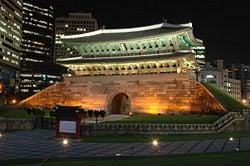Namdaemun (gate)
| Namdaemun (gate) | ||||||||
|---|---|---|---|---|---|---|---|---|
 | ||||||||
| Korean name | ||||||||
|
The South Korean government awarded Namdaemun, officially called Sungnyemun (숭례문, "Gate of Exalted Ceremony"), the honor of "National Treasure No.1", on December 20, 1962. The "nye" part of the name indicates the Confucian concept of "li" meaning order (rites or ceremonies) as well as associating with the direction South.
Situated in the heart of one of the busiest intersections in Seoul. Cars swarm around the gate, leaving little time for the drivers to grasp the historical significance of the landmark as they hurry to their next appointment. Until 2006, when the gate opened cars and pedistrans, traffic routed around Namdaemun serving as a landmark rather than an historical monument of gigantic historical porpotions.
Historical Background
Seoul, the capital of Korea from the founding the Joseon Dynasty in 1392 until today, had been a walled city with nine gates allowing traffic in and out of the city. The city founders constructed four main gates and five minor gates. The four main gates faced the four cardinal direction; north, south, east, and west. The south, east, and west gates opened at dawn and closed at dusk at the signal of the city bell. The north gate remained closed reserved for the king's escape to Pukhan Sansong or more distant fortifications during times of trouble. Yi T'aejo constructed all nine city gates along with Namdaemun gate in 1396 C.E. Namdaemun, literally "the southern gate," because it was the southern gate of the original walls surrounding Seoul.
Namdaemun is the oldest wooden structure surviving in Seoul. The construction of this gate began in 1395 during the fourth year of the reign of King Taejo of Joseon and was finished in 1398. Taejo directed architects to build Namdaemun facing Kwanak-san as a way of warding off the fire influences associated with that mountain.
King Sejong (the 4th king of the Yi Dynasty) tore down and rebuilt the gate, poorly built orginally, in 1447. Prince Yangnyǒng, the elder brother of King Sejǒng, wrote the calligraphy for the three Chinese characters (崇禮門) that designated the gate. The name board disappeared in 1592 during Hideyoshi's invasioin of Korea and turned up in a ditch during the reign of King Kwanghae (1609-1623). Seongjong renovated Namdaemun further in 1479, the the tenth year of his reign.
Namdaemun suffered damage from bombing during the Korean War 1950-1953. The city government debated demolishing the structure but opted to reconstruct the gate in the spring of 1962. The reconstruction begun in 1962 had been scheduled for completion by the time of the International Music Festival but the scope of the reconstruction made that impossible. Archeologists and their crews took the structure down to the ground level, covering the entire structure with a gigantic roof and semi-transparent screens.
During the repairs in 1962-1963, workers discovered records hiden under a ridge beam under the second roof that the precise date of the original construction in 1396. The record went on to report that 6,817 soldiers conscripted from Chǒnju in Chǒlla-do performed the manual labor. The roster listed twenty eight stone cutters, forty-four carpenters, sixty three riveters, five sculptors, along with 1,400 labors. The record even detailed the feast at the beam raising ceremony; 10,700 bottles of soju (Korean rice-based grain liquor) and 3,800 barrels of takchu (traditional Korean wine), and 1,500 head of cattle.
revealed an extenisve reconstruction carried out in 1479 during the reign of King Seongjong.
Description
As seen in the picture accompanying this article, Namdaemun has a paljak shaped roof (a roofing style with hip rafters attached to the four corners) that gracefully curves in double eves. The phoenix image, representing the king, is carved into the tiles in the upper eve while the dragon image, representing the queen, is carved into the tiles in the lower eve.
Between 1907-1908, under the Japanese occupation government, the city walls on either side of the gate were taken down to allow for the easier flow of traffic in the area.
Currently, Namdaemun serves as a gateway to Namdaemun market, a traditional twenty-four hour market that has been operating for centuries. The area is also home to several shopping malls. The gate is located halfway between Seoul Station and Seoul City Plaza. It's located in Jung-gu, Seoul, Namdaemun St 4-Ga 29.
ReferencesISBN links support NWE through referral fees
- Robert Nilsen, 1988. South Korea Handbook. Moon Publications: Chico, CA. ISBN 0-918373-20-4.
- Adams, Edward Ben. 1974. Through gates of Seoul: trails and tales of Yi dynasty, vol. 1-2. Seoul: Taewon Publishing Co. OCLC: 81771842, ASIN: B0007AR876.
- Clark, Allen D. and Clark, Donald N. 1969. Seoul past and present: a guide to Yi T'aejo's capital. Seoul, Hollym Corp. LC 77-125468. OCLC 567884.
External Links
See also
Credits
New World Encyclopedia writers and editors rewrote and completed the Wikipedia article in accordance with New World Encyclopedia standards. This article abides by terms of the Creative Commons CC-by-sa 3.0 License (CC-by-sa), which may be used and disseminated with proper attribution. Credit is due under the terms of this license that can reference both the New World Encyclopedia contributors and the selfless volunteer contributors of the Wikimedia Foundation. To cite this article click here for a list of acceptable citing formats.The history of earlier contributions by wikipedians is accessible to researchers here:
The history of this article since it was imported to New World Encyclopedia:
Note: Some restrictions may apply to use of individual images which are separately licensed.